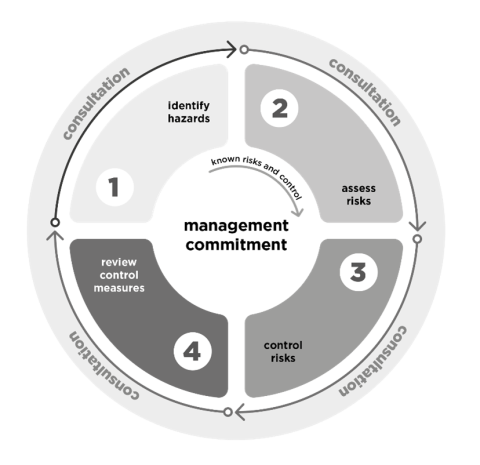Risk management is a four-step process. All the steps must be done in consultation with workers and their representatives.
Managing the risk of sexual and gender-based harassment may mean redesigning your workplace, the work or the way you do it. Training and policies alone are not effective or reliable controls.
For more information see the model Code of Practice: Sexual and gender-based harassment and the Code of Practice: Managing psychosocial hazards at work.
Identify and assess the risk of sexual and gender-based harassment
You must identify where sexual or gender-based harassment happens or could happen. An incident does not need to have happened for there to be a risk.
- Consult workers and their HSRs. Focus on the risk of sexual and gender-based harassment not just past incidents. This make it easier to speak up, helps manage confidentiality and privacy, and ensures you don’t miss identifying a risk just because nothing has been reported.
- Collect and review data and information. Review information and records you already have (e.g. complaints, grievances, reports, exit interviews, survey data) and collect any additional information you may need (e.g. consider anonymous surveys, seek advice from the WHS regulator, industry association, union, experts or similar workplaces).
- Observe the work, workplace and behaviours. Look at how the work is designed and how tasks are done, walk through the physical workplace to look for areas workers might be at risk, and observe how workers and others interact.
- Have a reporting mechanism. Ensure it maintains worker privacy, allows anonymous reporting where possible, suits your business, level of risks and workers including vulnerable workers. Workers experiencing multiple forms of harassment and discrimination are more likely to be harmed and may be less likely to report.
- Encourage reporting. You should encourage reporting and must not discriminate against workers for raising a WHS concern. Workers may be less likely to report harassment if other WHS hazards are poorly managed.
- Consider how long, often and severely workers are exposed to the risk. The longer (e.g. over a whole shift), more often (e.g. most days) and more severe the exposure (e.g. sexual assault) the more likely it is that workers will be harmed. Think about everywhere workers are likely to go at work, when work is done, who may harass workers, who is likely to be affected (e.g. some workers may be at greater risk), and the nature of the possible harassment.
- Identify other hazards present and consider them together. Hazards can interact and combine to create new, changed or higher risks. Sexual and gender-based harassment rarely occurs in isolation from other psychosocial hazards (e.g. high job demands, other harmful behaviours, remote or isolated work, low job control or poor support).
Control the risks
You must eliminate the risk of sexual and gender-based harassment, or if that is not reasonably practicable, minimise the risks so far as is reasonably practicable. This may mean redesigning your workplace, the work or the way you do it. Training and policies alone are not effective or reliable controls.
Every workplace is different so the best combination of control measures will depend on your work, workplace and workers. When determining what control measures to use you must have regard to all relevant matters including:
- Duration, frequency and severity. Reduce how long (e.g. minimise the number of tasks that are completed away from the usual workplace), how often (e.g. provide more services online to minimise customer interactions) and how severe the exposure to the risk is (e.g. use physical barriers to prevent sexual assault).
- How sexual and gender-based harassment may interact or combine with other psychosocial hazards to increase the risks. You may be able to minimise the risks by controlling other psychosocial hazards (e.g. poor support or organisational justice).
- The design of work including the job demands and tasks. Consider redesigning the work by changing the task (e.g. remove sexual innuendo from sales scripts), when the task is done (e.g. empty bins in the morning not at night), where the task is done (e.g. meet clients in the office not their home) and how the task is done (e.g. assign workers in pairs or small groups).
- The systems of work including how work is managed, organised and supported. Avoid systems of work that increase the risks (e.g. working alone, highly hierarchical workplaces, or rules stopping workers leaving a situation). Instead, implement systems of work that help control the risks (e.g. use work phone numbers and email addresses for work, have a way for workers to get immediate help if needed).
- The design, layout and environmental conditions of the workplace including safe entry and exit. Ensure good visibility and natural surveillance, improve security and privacy, ensure workers can move around the workplace freely without physical contact, and have safe places to retreat.
- Worker accommodation. You must also consider the design, layout and environmental conditions of any worker accommodation you own, manage or control (e.g. accommodation on remote worksites).
- The plant, substances and structures at the workplace. The things in your workplace can either increase or help control the risks (e.g. ensure communication systems work well even in an emergency, provide lifting equipment to minimise physical contact when handling patients, install software that blocks sexually explicit or offensive language).
- Workplace interactions or behaviours. Poor organisational culture makes it harder to manage risks. Address this by building supportive leadership, influencing worker behaviour (e.g. have behavioural policies and hold workers to them, ensure responsible service of alcohol at work-related events) and managing others’ behaviour (e.g. where possible ban patrons with a history of harassment, communicate a no harassment policy to customers).
- The information, training, instruction and supervision provided to workers. Supervision can directly control some harassment risks (e.g. harassment is less common when people think they might be seen or get into trouble). Information, training and instruction can also help you implement control measures effectively (e.g. train workers in processes and how to raise concerns).
Maintain and review
Maintain and review control measures to ensure they are working as planned. If a control measure is not working effectively, you must modify and replace it.
Investigating and responding to reports
Internal WHS investigations should focus on protecting workers and others from harm by identifying if there:
- is a risk of sexual or gender-based harassment which has not been controlled so far as is reasonably practicable, or
- are more effective and reliable control measures available.
You don’t need a formal complaint to do a WHS investigation and an allegation does not have to be substantiated for there to be a WHS risk which needs to be managed.

